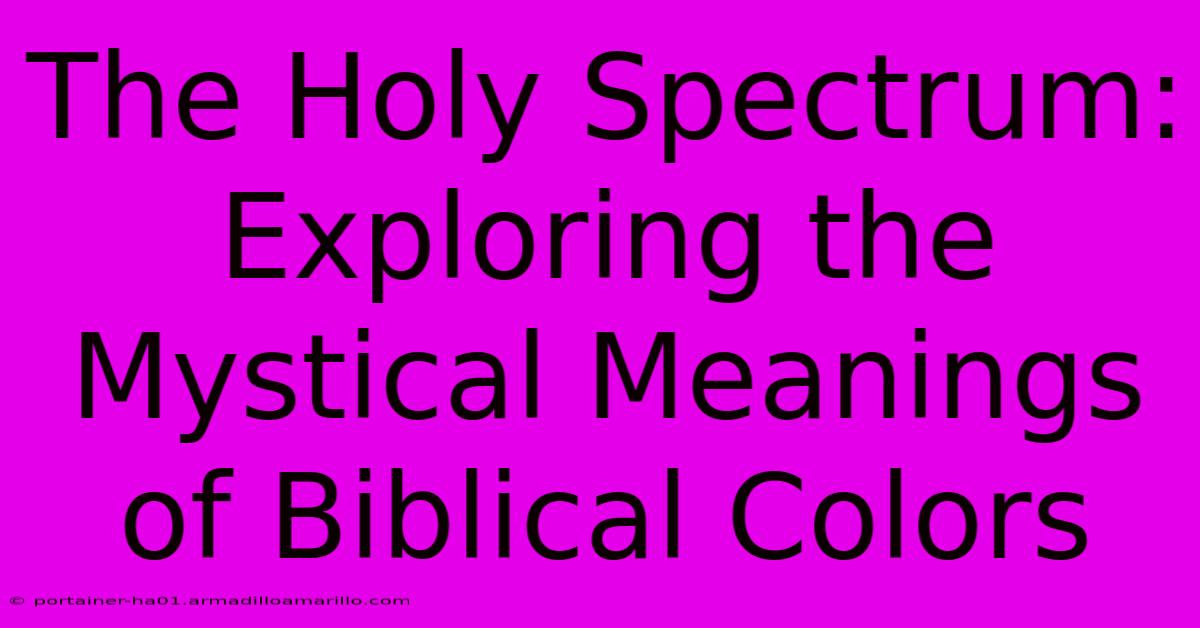The Holy Spectrum: Exploring The Mystical Meanings Of Biblical Colors

Table of Contents
The Holy Spectrum: Exploring the Mystical Meanings of Biblical Colors
Color, often overlooked, plays a surprisingly significant role in the Bible. Far from being mere aesthetic choices, the hues mentioned throughout scripture carry deep symbolic weight, conveying complex theological concepts and enriching our understanding of biblical narratives. This exploration delves into the mystical meanings of these biblical colors, unveiling their rich tapestry of spiritual significance.
Red: Blood, Sacrifice, and the Divine Wrath
Red, the color of blood, is powerfully associated with sacrifice and atonement in the Bible. The blood of lambs, goats, and ultimately, Jesus Christ, serves as a potent symbol of redemption. Exodus 24:8, depicting Moses' covenant with God, emphasizes the sprinkling of blood, signifying a binding agreement sealed through sacrifice. The crimson hue also represents the divine wrath and judgment of God, as seen in the plagues of Egypt and the descriptions of apocalyptic events in the Book of Revelation.
Key Biblical References:
- Exodus 12:7: The Passover lamb's blood protects the Israelites.
- Revelation 6:4: The rider on a red horse signifies war and bloodshed.
- Isaiah 1:18: God's promise of cleansing, symbolized by removing the scarlet sin.
White: Purity, Holiness, and Triumph
White consistently represents purity, holiness, and the victory of good over evil. The garments of priests, angels, and the resurrected Christ are frequently described as white, symbolizing their spiritual perfection and closeness to God. This color signifies cleansing from sin, a new beginning, and the glorious triumph of faith.
Key Biblical References:
- Revelation 6:11: Martyrs clothed in white robes, signifying their righteousness.
- Revelation 7:9: A vast multitude dressed in white robes, representing those redeemed.
- Daniel 7:9: The Ancient of Days clothed in white, representing divine majesty.
Blue: Heaven, Divine Presence, and Faithfulness
Blue, often associated with the vast expanse of the heavens, signifies God's divine presence and faithfulness. The priestly garments, adorned with blue, represented their connection to the heavenly realm. The color also symbolizes hope, faith, and steadfastness, guiding believers toward spiritual fulfillment.
Key Biblical References:
- Exodus 28:6: The blue thread in the priestly garments, signifying divine connection.
- Ezekiel 1:26: The likeness of a sapphire, representing God's throne and glory.
- Psalm 139:14: The heavens being blue and vast, reflecting God's immensity.
Green: New Life, Renewal, and Resurrection
Green's association with nature reflects themes of renewal, growth, and the promise of new life. The imagery of flourishing gardens and verdant landscapes in scripture often signifies God's restorative power and the promise of resurrection. It conveys hope, restoration, and the enduring power of faith.
Key Biblical References:
- Isaiah 55:13: The imagery of the wilderness blooming and flourishing.
- Revelation 7:3: “A great multitude…which no man could number, of all nations, and kindreds, and people, and tongues” described, suggesting the broad, multi-cultural reach of God’s love.
- 2 Kings 19:32: God promises that Jerusalem will be delivered from Assyrians.
Black: Darkness, Sin, and Judgment
Black, representing darkness and absence of light, symbolizes sin, death, and divine judgment. The darkness associated with evil and the absence of God's presence underscores the consequences of disobedience and the severity of divine wrath.
Key Biblical References:
- Matthew 22:13: The parable of the wedding feast, where those improperly dressed were cast out into outer darkness.
- Revelation 6:5: The black horse symbolizes famine and death.
Purple/Violet: Royalty, Power, and Divine Majesty
Purple, often used for royal garments, signifies regal authority, power, and the divine majesty of God. The use of purple in biblical contexts underscores God's supreme dominion and sovereignty.
Key Biblical References:
- Esther 1:6: The lavish use of purple in the king's palace, showing the extravagance of royalty.
This exploration only scratches the surface of the rich symbolism inherent in biblical colors. Their intricate meanings weave a deeper understanding of scriptural narratives, revealing profound theological insights and enhancing our connection to the divine. Further study of these colors within their specific contexts illuminates the vibrant tapestry of faith and belief embedded within the Bible's pages.

Thank you for visiting our website wich cover about The Holy Spectrum: Exploring The Mystical Meanings Of Biblical Colors. We hope the information provided has been useful to you. Feel free to contact us if you have any questions or need further assistance. See you next time and dont miss to bookmark.
Featured Posts
-
Beyond The Ivory Tower Pearly Pink In D And D For A Touch Of Ethereal Enchantment
Feb 07, 2025
-
The Future Of Communication Mail Hosting Trends To Watch In 2024
Feb 07, 2025
-
A Chosen Journey Uncover The Divine Purpose Behind Your Christian Identity
Feb 07, 2025
-
The Appliance That Inspires Unleash Your Inner Chef With The Retro Magic Of Big Chill
Feb 07, 2025
-
Discover The Oasis In The Desert 50 South Fourth Street Henderson Nv Awaits
Feb 07, 2025
